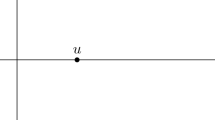Abstract
Sheppard et al (1992) introduced a spatial interdependent markets model for a single commodity and derived existence and stability properties of sales and prices at equilibrium under two price adjustment mechanisms and two profit-seeking scenarios. This paper explores the spatial properties of the sales and price configurations. Equilibrium prices are given two interpretations that relate to two different aspects of inter-market consumer flows for the purpose of purchasing the commodity. Subsequently the paper describes how sales and prices can be separated into an element reflectinglocational advantage which arises from the overlapping of juxtaposed consumer choice sets of different sizes and an element reflectingmarket interaction which arises because of consumer sensitivity to price differences between sites within their choice set. Configurations of sales and prices are generated explicitly for certain spatial systems. The two profit objectives lead to strikingly different spatial price distributions. Equilibrium prices and sales under both profit objectives appear to be quite closely tied to the prices and sales that are generated by the choice set structure (locational advantage) after smoothing by a local scale spatial operator. The relationships between prices and sales due to locational advantage and prices and sales at equilibrium are analyzed.
Similar content being viewed by others
References
Anderson, S. P. and de Palma, A. 1989. The logit as a model of product differentiation: Further Results and Extensions,The Center for Mathematical Studies in Economics & Management Science, Discussion paper 913. Northwestern University.
Anderson, S. P. and de Palma, A. 1992. The logit as a model of product differentiation.Oxford Economic Papers, 44: 51–67.
Chamberlin, E. H. 1933. Theory of Monopolistic Competition. Cambridge: Harvard University Press.
de Palma, A., Labbé, M. and Thisse, J. F. 1986. On the Existence of Price Equilibria under Mill and Uniform Delivered Pricing Policies. In G. Norman (ed.),Spatial Pricing in Differentiated Markets. London: Pion pp. 30–41.
de Palma, A., Lindsey, R., von Hohenbalken, B. and West., D. S. 1991. Spatial price and variety competition in an urban retail market: a nested logit analysis.Research Paper No91-21, Dept. of Economics, University of Alberta, Edmonton.
Fik, T.J. 1991 Price competition and node-linkage association,Papers in Regional Science, 70: 53–69.
Garbow, B. S., Hillstrom, K. E., More, J. J. 1980. User Guide for Minpack. Argonne National Laboratories.
Haining, R. 1984. Testing a spatial interacting-markets hypothesis.Review of Economics & Statistics, 66: 576–83.
Kreps, D. 1990. A Course in Microeconomic theory. Princeton: Princeton University Press.
Mulligan, G. F. and Timothy, J. F. 1989a. Price Variation in Spatial Oligopolies.Geographical Analysis, 21: 32–46.
Mulligan, G. F., Timothy J. F. 1989b. Asymmetrical Price Conjectural Variation in Spatial Competition Models.Economic Geography, 65: 19–32.
Nagurney, A. 1988. Algorithms for oligopolistic market equilibrium problems.Regional Science and Urban Economics, 18: 425–47.
Powell, M. J. D. 1970. A Hybrid Method for Nonlinear Equations. In: Rabinowitz, P.Numerical Methods for Nonlinear Algebraic Equations. New York: Gordon & Breach.
Robinson, J. 1971. The Economics of Imperfect Competition. London: Macmillan.
Schendel, D. E., Balestro, P. 1969. Retail behavior and Gasoline price wars.Applied Economics. 1: 85–101.
Shepard, A. 1991. Price discrimination and retail configuration.Journal of Political Economy. 99: 30–53.
Sheppard, E. R., Haining, R. and Plummer, P. 1992. Spatial pricing in interdependent markets.Journal of Regional Science. 32: 55–75.
Slade, M. 1989. Price wars in price setting supergames.Economica, 56: 295–310.
Slade, M. 1992. Vancouvers gasoline price wars: an empirical exercise in uncovering supergame strategies,Review of Economic Studies. 59: 257–276.
U.S. Bureau of the Census. 1987a.County Business Patterns. U.S. Government Printing Office, Washington D.C.
U.S. Bureau of the Census. 1987b.Census of Retail Trade. U.S. Government Printing Office, Washington D.C.
U.S. Dept. of Energy. 1981.State of Competition in Gasoline Marketing. National Technical Information Service, Springfield VA.
U.S. Dept. of Energy. 1987.Petroleum Marketing Monthly. U.S. Government Printing Office, Washington, D.C.
Author information
Authors and Affiliations
Rights and permissions
About this article
Cite this article
Haining, R., Plummer, P. & Sheppard, E. Spatial price equilibrium in interdependent markets: Price and sales configurations. Papers in Regional Science 75, 41–64 (1996). https://doi.org/10.1007/BF02406959
Issue Date:
DOI: https://doi.org/10.1007/BF02406959




